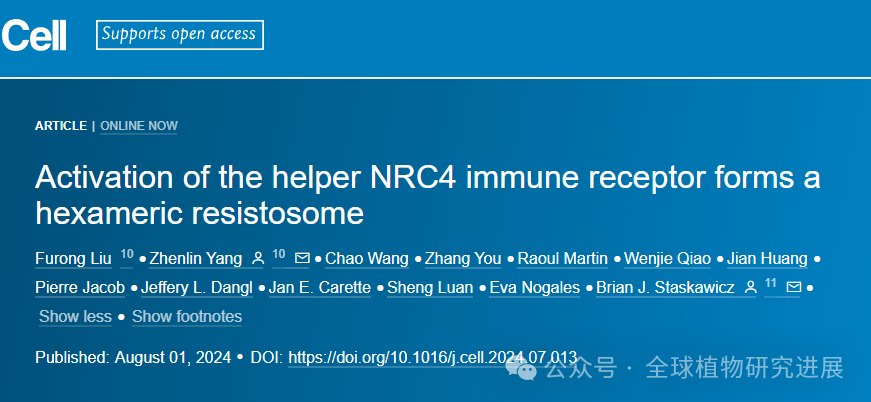2024年8月1日,美国加州大学伯克利分校植物与微生物生物学系Brian J. Staskawicz院士作为通讯作者在Cell发表了题为“Activation of the helper NRC4 immune receptor forms a hexameric resistosome(辅助NRC4免疫受体的激活形成六聚体抗病小体)”的研究论文。第一作者为Furong Liu(刘富荣),曾师从康振生院士、Pamela C. Ronald院士、Brian Staskawicz院士。
美国加州大学伯克利分校栾升教授、加州大学伯克利分校杰出教授Eva Nogales、美国斯坦福大学医学院Jan E. Carette教授、北卡罗来纳大学教堂山分校生物系和霍华德休斯医学研究所Jeffery L. Dangl教授等参与了该研究。

论文精髓
NRC0、NRC2、NRC3和NRC4在激活后形成六聚体抗病小体。
NRC4和NRC3抗病小体引发植物钙内流和免疫反应。
NRC激活需要植物特定的钙流入因子。
摘要
对微生物病原体的先天免疫反应是由植物和动物界中称为核苷酸结合富含亮氨酸重复受体(NLR)的细胞内受体调节的。在植物的先天免疫系统中,“辅助”NLR(hNLR)与“传感器”NLRs(sNLR)协同工作,调节抗病信号通路。基于结构的hNLR激活机制尚不清楚。我们的研究表明,hNLR,即细胞死亡4(NRC4)所需的NLR,在被sNLR Bs2和致病效应子AvrBs2激活后组装成六聚体抗病小体。这种构象变化通过促进钙离子(Ca2+)流入细胞质来引发免疫反应。单独使用NRC2、NRC3或NRC4的激活模拟等位基因不会诱导动物细胞中的Ca2+内流和细胞死亡,这表明未知的植物特异性因素调节植物中NRCs的激活。这些发现大大推进了我们对植物免疫反应调控机制的理解。

Summary
Innate immune responses to microbial pathogens are regulated by intracellular receptors known as nucleotide-binding leucine-rich repeat receptors (NLRs) in both the plant and animal kingdoms. Across plant innate immune systems, “helper” NLRs (hNLRs) work in coordination with “sensor” NLRs (sNLRs) to modulate disease resistance signaling pathways. Activation mechanisms of hNLRs based on structures are unknown. Our research reveals that the hNLR, known as NLR required for cell death 4 (NRC4), assembles into a hexameric resistosome upon activation by the sNLR Bs2 and the pathogenic effector AvrBs2. This conformational change triggers immune responses by facilitating the influx of calcium ions (Ca2+) into the cytosol. The activation mimic alleles of NRC2, NRC3, or NRC4 alone did not induce Ca2+ influx and cell death in animal cells, suggesting that unknown plant-specific factors regulate NRCs’ activation in plants. These findings significantly advance our understanding of the regulatory mechanisms governing plant immune responses.